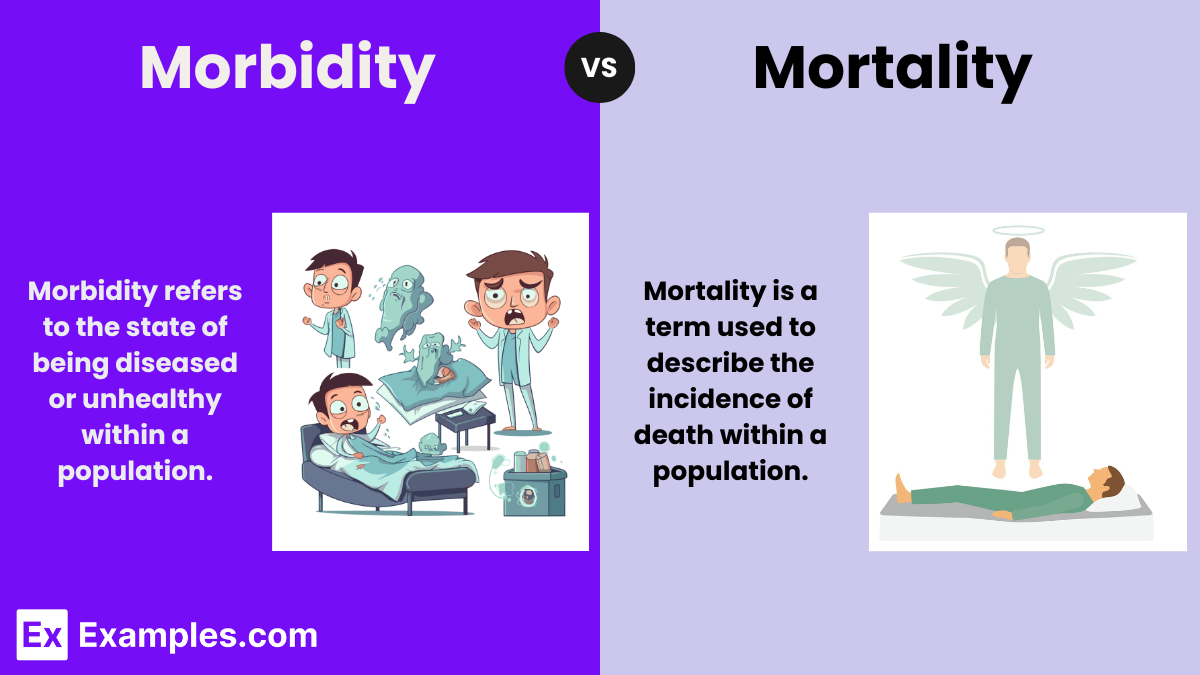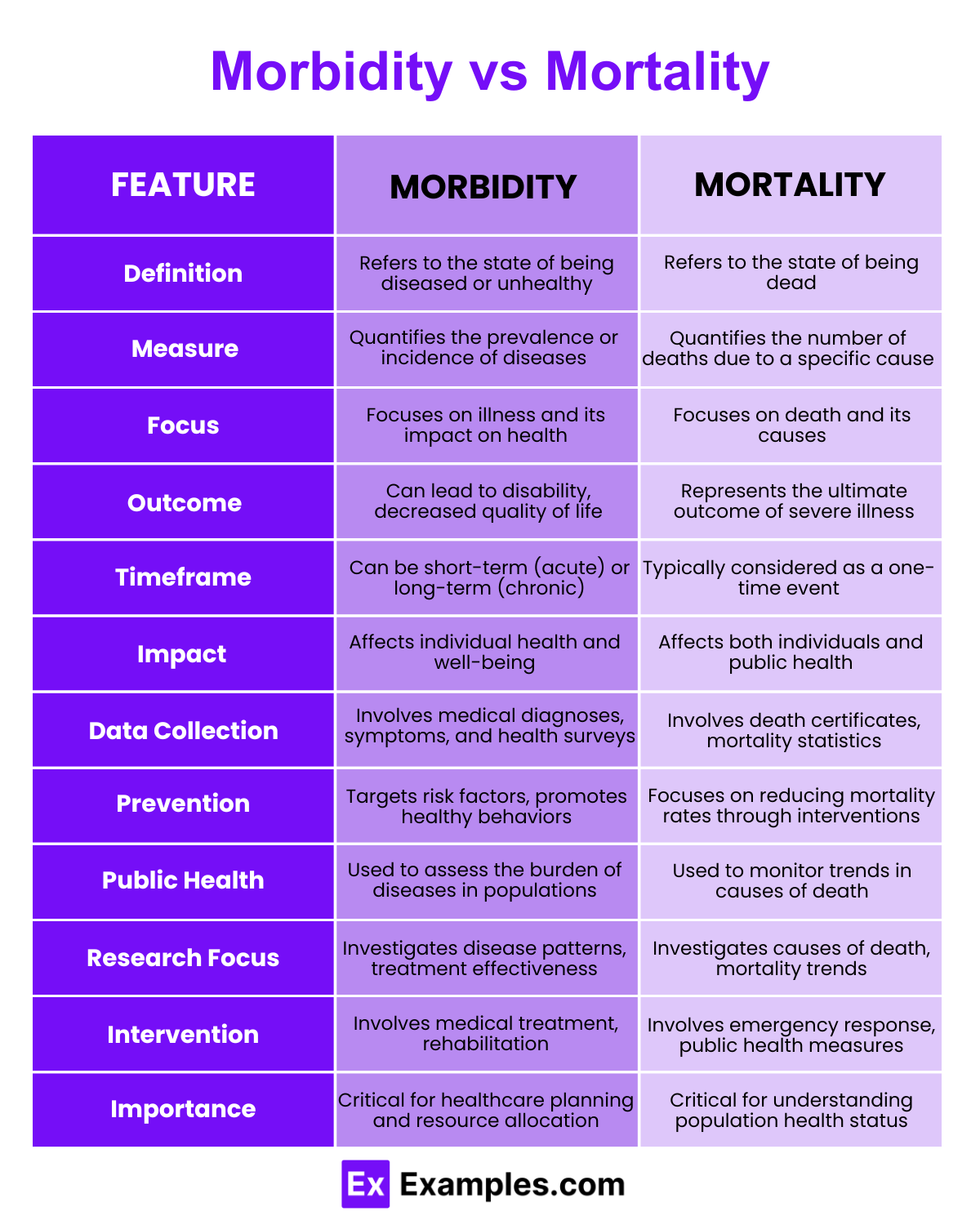Which term refers to the incidence of disease in a population?
Mortality
Morbidity
Fatality
Recovery

Morbidity and mortality are two pivotal metrics used in public health to describe the health status of populations and the impact of diseases. Morbidity refers to the incidence or prevalence of a disease or medical condition within a population. It highlights the extent of illness, injury, or disability in a defined population. Mortality, on the other hand, measures the frequency of deaths in a population. Understanding the distinction between these terms is crucial for health professionals and researchers as they assess the severity and spread of diseases, guide treatment protocols, and shape preventative healthcare policies.
Morbidity refers to the state of being diseased or unhealthy within a population. It is commonly used to describe the incidence or prevalence of a disease or the degree of risk associated with a particular health condition. Morbidity can encompass both physical and psychological conditions, affecting overall health and quality of life.
A common example of morbidity is the prevalence of diabetes in a population. For instance, if a study finds that 15% of a population in a certain city has diabetes, this statistic represents the morbidity rate of diabetes within that community.
Morbidity is not just about counting how many people are sick; it also concerns the levels and types of illnesses present within a community. It can be categorized into:
Mortality is the term used to describe the incidence of death within a population. It is a vital statistic for understanding the health status of a community or a country, often used in public health to assess the effectiveness of health policies and interventions.
An example of mortality can be seen in the death rates due to heart disease. For example, if it is reported that there are 200 deaths due to heart disease per 100,000 individuals annually in a region, this figure represents the mortality rate from heart disease in that area.
Mortality can also be categorized based on different aspects of health and disease:

| Aspect | Morbidity | Mortality |
|---|---|---|
| Definition | Refers to the state of being diseased or the incidence of disease within a population. | Refers to the incidence of death within a population. |
| Purpose of Measurement | To assess the health condition and disease burden in a population. | To measure the rate of death to assess overall population health and lifespan. |
| Key Indicators | – Prevalence (total number of disease cases at a given time) | – Crude mortality rate (total deaths per year per 1,000 individuals) |
| – Incidence (number of new cases in a given period) | – Age-specific mortality rate (deaths by age group) | |
| – Severity of illness | – Cause-specific mortality rate (deaths by specific causes) | |
| Types | – Acute morbidity (short-term diseases) | – Infant mortality (deaths of infants under one year old per 1,000 live births) |
| – Chronic morbidity (long-term or lifelong conditions) | – Maternal mortality (deaths due to pregnancy-related causes per 100,000 live births) | |
| – Comorbidity (presence of more than one disease or condition simultaneously) | – Mortality rate from specific diseases (e.g., cancer, heart diseases) | |
| Impact | – Influences health care planning and resource allocation | – Indicates health care needs and effectiveness of health interventions |
| – Affects quality of life and productivity | – Impacts demographic statistics and economic factors | |
| Usage in Public Health | – To identify disease patterns and risk factors | – To evaluate and improve health policies and life expectancy |
| – To design and implement preventative measures and treatments | – To prioritize public health issues and interventions |
Morbidity and mortality are critical terms used in the field of epidemiology, public health, and medical research to describe and measure health outcomes. Despite their distinct meanings, these terms share several similarities that are important for understanding health trends and the effectiveness of healthcare interventions.
Both morbidity and mortality focus on health outcomes but from different perspectives. Morbidity refers to the prevalence or risk of diseases, conditions, or injuries within a population, indicating the health status and quality of life. Mortality, on the other hand, refers to the incidence of death within a population. Their commonality lies in their use as indicators to assess the burden of disease on a society and the effectiveness of healthcare systems.
Both terms are extensively used in epidemiological studies to track, analyze, and compare health conditions over time and across different geographic and demographic groups. Researchers use morbidity and mortality rates to understand the impact of diseases, to identify public health priorities, and to guide health policies and resource allocation.
Morbidity and mortality data are pivotal in shaping public health decisions and interventions. High rates of morbidity and mortality can lead to increased public health efforts, such as vaccination programs, health education campaigns, and changes in healthcare policy. They help health authorities to determine where to focus their efforts in order to improve overall population health.
Both morbidity and mortality are measured using specific epidemiological tools and statistics. Morbidity might be measured through incidence and prevalence rates, while mortality is often measured using mortality rates, life expectancy, and death rates. These measurements are crucial for public health surveillance and for evaluating health interventions and outcomes.
Morbidity and mortality rates are important indicators of health disparities within and between populations. They help identify groups that are disproportionately affected by certain health conditions or have higher death rates. This can highlight areas of inequality in health outcomes related to factors such as socioeconomic status, race, ethnicity, and geographical location.
Mortality measures death rates, while morbidity focuses on disease prevalence and its impact on life quality.
An example of morbidity is the incidence of diabetes within a specific population.
Morbidity is often referred to as illness or disease frequency within a population.
Mortality tracks death rates, prevalence measures the proportion of individuals affected by a disease, and morbidity indicates the disease’s impact on health.
An example of both morbidity and mortality is the number of people suffering from heart disease and the deaths resulting from it.
Text prompt
Add Tone
10 Examples of Public speaking
20 Examples of Gas lighting
Which term refers to the incidence of disease in a population?
Mortality
Morbidity
Fatality
Recovery
Mortality rate measures:
The number of new cases of a disease
The number of recoveries from a disease
The number of deaths in a population
The number of hospital admissions
Which of the following best describes morbidity?
The presence of illness or disease
The number of healthy individuals
The rate of childbirth
The number of fatalities
Which of the following indicates a higher mortality rate?
Decrease in death rate
Increase in death rate
Constant death rate
No deaths recorded
Morbidity rates are useful for:
Tracking disease spread
Calculating death rates
Estimating birth rates
Measuring economic growth
Which factor is directly measured by mortality?
Quality of life
Life expectancy
Deaths
Chronic illnesses
If a country has a high morbidity rate but low mortality rate, it means:
Many people are dying from diseases
The population is very healthy
Few people have diseases
Many people have diseases but few die from them
Which of the following would be considered a measure of morbidity?
Infant mortality rate
Annual death rate
Life expectancy at birth
Prevalence of diabetes
Mortality data is crucial for:
Understanding the burden of non-fatal diseases
Assessing the impact of fatal diseases
Monitoring economic trends
Estimating population growth
What does a decrease in morbidity rates suggest?
Improvement in health conditions
Increase in birth rates
Higher death rates
Worsening of health conditions
Before you leave, take our quick quiz to enhance your learning!

